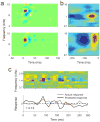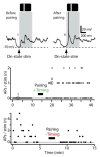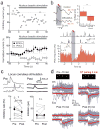Synaptic plasticity as a cortical coding scheme
- PMID: 26497430
- PMCID: PMC4641776
- DOI: 10.1016/j.conb.2015.10.003
Synaptic plasticity as a cortical coding scheme
Abstract
Processing of auditory information requires constant adjustment due to alterations of the environment and changing conditions in the nervous system with age, health, and experience. Consequently, patterns of activity in cortical networks have complex dynamics over a wide range of timescales, from milliseconds to days and longer. In the primary auditory cortex (AI), multiple forms of adaptation and plasticity shape synaptic input and action potential output. However, the variance of neuronal responses has made it difficult to characterize AI receptive fields and to determine the function of AI in processing auditory information such as vocalizations. Here we describe recent studies on the temporal modulation of cortical responses and consider the relation of synaptic plasticity to neural coding.
Copyright © 2015 Elsevier Ltd. All rights reserved.
Conflict of interest statement
We wish to confirm that there are no known conflicts of interest associated with this publication and there has been no significant financial support for this work that could have influenced its outcome.
We confirm that the manuscript has been read and approved by all named authors and that there are no other persons who satisfied the criteria for authorship but are not listed.
We further confirm that the order of authors listed in the manuscript has been approved by all of us.
We confirm that we have given due consideration to the protection of intellectual property associated with this work and that there are no impediments to publication, including the timing of publication, with respect to intellectual property. In so doing we confirm that we have followed the regulations of our institutions concerning intellectual property.
We further confirm that any aspect of the work covered in this manuscript that has involved either experimental animals or human patients has been conducted with the ethical approval of all relevant bodies and that such approvals are acknowledged within the manuscript.
We understand that the Corresponding Author is the sole contact for the Editorial process (including Editorial Manager and direct communications with the office). He/she is responsible for communicating with the other authors about progress, submissions of revisions and final approval of proofs. We confirm that we have provided a current, correct email address which is accessible by the Corresponding Author and which has been configured to accept email from:
Figures





Similar articles
-
Spectral tuning of adaptation supports coding of sensory context in auditory cortex.PLoS Comput Biol. 2019 Oct 18;15(10):e1007430. doi: 10.1371/journal.pcbi.1007430. eCollection 2019 Oct. PLoS Comput Biol. 2019. PMID: 31626624 Free PMC article.
-
Multiple Timescales Account for Adaptive Responses across Sensory Cortices.J Neurosci. 2019 Dec 11;39(50):10019-10033. doi: 10.1523/JNEUROSCI.1642-19.2019. Epub 2019 Oct 29. J Neurosci. 2019. PMID: 31662427 Free PMC article.
-
Spectrotemporal dynamics of auditory cortical synaptic receptive field plasticity.Hear Res. 2011 Sep;279(1-2):149-61. doi: 10.1016/j.heares.2011.03.005. Epub 2011 Mar 21. Hear Res. 2011. PMID: 21426927 Free PMC article. Review.
-
Synaptic mechanisms underlying auditory processing.Curr Opin Neurobiol. 2006 Aug;16(4):371-6. doi: 10.1016/j.conb.2006.06.015. Epub 2006 Jul 13. Curr Opin Neurobiol. 2006. PMID: 16842988 Review.
-
Processing of complex stimuli and natural scenes in the auditory cortex.Curr Opin Neurobiol. 2004 Aug;14(4):474-80. doi: 10.1016/j.conb.2004.06.005. Curr Opin Neurobiol. 2004. PMID: 15321068 Review.
Cited by
-
Time and information in perceptual adaptation to speech.Cognition. 2019 Nov;192:103982. doi: 10.1016/j.cognition.2019.05.019. Epub 2019 Jun 21. Cognition. 2019. PMID: 31229740 Free PMC article.
-
Heterogeneous associative plasticity in the auditory cortex induced by fear learning - novel insight into the classical conditioning paradigm.Physiol Res. 2021 Jul 12;70(3):447-460. doi: 10.33549/physiolres.934559. Epub 2021 May 12. Physiol Res. 2021. PMID: 33982575 Free PMC article.
-
Driving reservoir models with oscillations: a solution to the extreme structural sensitivity of chaotic networks.J Comput Neurosci. 2016 Dec;41(3):305-322. doi: 10.1007/s10827-016-0619-3. Epub 2016 Sep 2. J Comput Neurosci. 2016. PMID: 27585661
-
Contrast Enhancement without Transient Map Expansion for Species-Specific Vocalizations in Core Auditory Cortex during Learning.eNeuro. 2016 Nov 30;3(6):ENEURO.0318-16.2016. doi: 10.1523/ENEURO.0318-16.2016. eCollection 2016 Nov-Dec. eNeuro. 2016. PMID: 27957529 Free PMC article.
-
How neuroscience can inform the study of individual differences in cognitive abilities.Rev Neurosci. 2017 May 24;28(4):343-362. doi: 10.1515/revneuro-2016-0073. Rev Neurosci. 2017. PMID: 28195556 Free PMC article. Review.
References
-
- Diamond IT, Neff WD. Ablation of temporal cortex and discrimination of auditory patterns. J Neurophysiol. 1957;20:300–315. - PubMed
-
- Kaas JH, Axelrof S, Diamond IT. An ablation study of the auditory cortex in the cat using binaural tonal patterns. J Neurophysiol. 1967;30:710–724. - PubMed
-
- Marlin BJ, Mitre M, D’amour JA, Chao MV, Froemke RC. Oxytocin enables maternal behaviour by balancing cortical inhibition. Nature. 2015;520:499–504. Here we examined pup retrieval behavior in co-housed virgin mice. Maternal mice responded to ultrasonic distress calls, and co-housed virgins began to respond after several days. Left but not right auditory cortex was required for this behavior, and left auditory cortical neurons were particularly sensitive to pup call stimuli. Oxytocin in left auditory cortex (pharmacologically applied or optogenetically released) facilitated onset of pup retrieval behavior, and enabled a form of plasticity where initially untuned neurons in virgin animals became tuned to pup calls by reorganizing excitatory and inhibitory synaptic inputs. - PMC - PubMed
Publication types
MeSH terms
Grants and funding
LinkOut - more resources
Full Text Sources
Other Literature Sources

